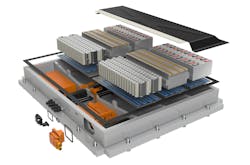Battery Packaging Architectures: Materials Considerations
What you’ll learn:
- Trends in next-generation battery packaging architectures.
- Optimizing packaging space with cell-connecting systems.
- Novel solutions for solving EMI, thermal management, and range-anxiety challenges.
Battery packaging can play a critical role in better ensuring battery safety, efficiency, performance, and long-service life. In the next generation of electric-vehicle (EV) battery packs, advances in material dynamics can help meet customer and consumer demands for battery safety, performance, lifecycle, cost, and environmental impact.
Battery production technology must align with what’s most important to consumers as well as regulatory requirements: Safety, performance, overall cost to own and maintain (parity with ICE), and an anticipated lifecycle of up to 15 years—all of these are factors to be considered.
Sustainability is under scrutiny, too, and environmental impact must be carefully addressed. When considering these issues as they relate to next-generation batteries, battery packaging rises to the forefront of design. Key factors to consider for next-generation EV batteries include a growing need for advances in battery packaging to keep pace with ever-evolving battery technology.
Benefits of Advanced Battery Packaging
Packaging not only ensures the efficient use of available energy but also reduces the environmental impact of battery systems. This is achieved through the increased use of lightweight materials, smart packaging technologies, modular designs, environmentally friendly materials, innovative solutions for thermal management, integration of wireless charging technology, and advanced packaging solutions for mechanical protection. For example:
- Increased use of lightweight materials, such as composites or advanced plastics, reduces weight and improves fuel economy. The use of smart packaging technologies, such as sensors and microcontrollers, helps to monitor the battery, optimizes performance, and extends the battery's life. Modular designs for battery packs and cells make battery systems easier to customize, and environmentally friendly packaging materials and recycling processes reduce the impact of battery systems on the environment.
- Innovative packaging solutions for the thermal management of battery systems, such as new cooling materials and heat-dissipation technologies, lead to improved performance and battery life. Integration of wireless-charging technology into the packaging makes it possible for users to recharge batteries without having to plug them in.
Developing new battery packaging architecture poses several challenges, though, including safety concerns that require extensive testing and validation that will, in the short term, raise R&D costs. In addition, the need for specialized manufacturing equipment, integration with complex existing powertrain systems, and supply-chain limitation for new materials, will require advanced planning. Also challenging will be compliance with strict regulations and standards related to safety, performance, and environmental impact.
Sustainability considerations, including recyclable or biodegradable packaging materials and safe disposal of hazardous materials will need to be factored into any solution suitable for mass production. It will take a collaborative effort to achieve success with manufacturers, suppliers, researchers, and regulators all working together.
Battery-Management System Considerations
When it comes to the battery-management system (BMS), one of its most important roles is to contain the components and systems that mitigate electromagnetic interference (EMI). As more electronic components like power modules and sensors are added to high-voltage batteries, it increases the chances for EMI that can cause data inaccuracies or system failures. Clear data signals are crucial when situations occur in which the battery may be non-responsive, low performing, or in thermal crisis.
EMI sealing gaskets, absorbers, fabric over foam, conductive foam, and thermal interface materials—like those offered by DuPont’s Laird Division—help protect electronics from radio-frequency interference while also transferring heat and minimizing vibrations (see figure). An added benefit to these EMI shielding solutions is the ability to replace heavier and more expensive steel or aluminum components with composite materials.
Space is at a premium in BMS and sometimes rigid boards can be problematic both due to space constraints and vibrational energy that can sometimes dislodge components, causing performance and maintenance issues. Flexible circuits and cables allow for conformance with irregularly shaped areas due to bending and folding advantages.
Flexible circuit integration helps cut down on the number of connectors. Installation costs can therefore be reduced, and during the application development stage, designers are able to be more creative. DuPont’s flexible circuit and cable solutions work to enable engineering packaging freedom, electrical integrity for miniaturization, weight savings, and data throughput while providing consistent performance and durability.
Advanced Materials for Battery Thermal Management
Electronic components are crucial for battery functionality and the power generation required to link to communication, safety, and navigation systems. Depending on the specific application, these components must either generate or dissipate heat. To achieve this, advanced materials such as films, laminates, pads, and wraps are necessary.
For example, thermally conductive films can enhance the power output of PTC heaters that warm batteries during startup, while their application on busbars helps prevent overheating and offers dielectric protection.
Furthermore, the incorporation of thermal interface material (TIM) allows for components to effectively dissipate heat. This results in improved performance, optimizing the battery temperature during charging and operation. Safety is also improved with temperature control that helps avoid potential thermal runaway events, extending the service life of the battery while lowering warranty and maintenance costs.
Range anxiety is a factor in consumer adoption of EVs, and the right insulating materials for electronics can help address that issue. Temperature control of the entire battery pack is the best way to increase range and maintain battery life, as they work best in a specific temperature range. Temperatures that fluctuate—either too hot or too cold—will lead to degradation of efficiency, power output, and service life, all of which negatively impact efficient charging and range.
Integrating circuits with double-sided clad laminates can address battery heating while flexible laminates, coverlays, and adhesives enable maintaining battery connection systems and sensors. These types of materials offer necessary temperature controlling capabilities while also providing flexibility of design and reduced space, weight, and cost versus rigid counterparts.
Metal product solutions are important as well. Metal parts perform as heatsinks to draw high temperatures away from critical operating components. Precision custom metal product solutions allow for innumerable options, including design flexibility, compatibility with other systems, durability, and lower error in high-speed production rates. Among the array of metal product solutions are deep drawn covers, component housings, brackets, midplates, EMI fingerstock, and SMD grounding contacts.
In conclusion, all good solutions begin with application development expertise. Collaboration is essential to success, and DuPont is ready to work with anyone on battery-pack development.
About the Author
Susan M. Herczeg
DuPont Automotive Marketing Leader
Susan M. Herczeg is Marketing Leader for DuPont Automotive.

